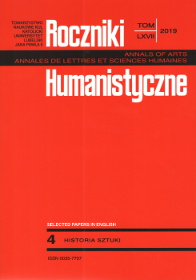Ludomir Sleńdziński’s Trips to Italy 1923–1925
Abstract
The Polish version of the article was published in Roczniki Humanistyczne vol. 60, issue 4 (2012).
Ludomir Sleńdziński was the main representative of classicism in Polish art in the period between the two World Wars. The article discusses his two trips to Italy in 1922/24 and 1924/25. They have not been yet researched in the context of the origin and character of his work, albeit impulses coming from Italy were thought to have been an important catalyst for the birth of the so-called “return to order.”
Sleńdziński was Dmitry Kardovsky’s student at the Academy of Fine Arts in Sankt Petersburg, and it was in his class that he acquired a worship of the old masters and a perfect command of his trade, first of all perfect drawing skills. Apart from the Sankt Petersburg school, classicist trends came to Polish art from Paris where they were first noticed in the circles connected with the Museion magazine (1911-1913) and among artists belonging to the Polish colony, such as Henryk Kuna, Edward Wittig and Eugeniusz Żak.
In the article, I reconstruct Sleńdziński’s tour of Italy, and I remind about the exhibition of Polish modern art that he staged in 1925 as part of the 3rd Roman Biennale. His personal contact with old and modern Italian art became an important moment in his artistic formation, stimulating his departure from academic towards modern classicism, in which the artist starts playing a game with the present day and with tradition, consciously using stylistic elements that belong to different epochs.
In conclusion it must be said that Ludomir’s trips inclined him to introduce many new solutions (sometimes surprisingly close to works by well-known Italian artists of similar outlook) and determined the final shape of his mature work.
References
Anders, Henryk. Rytm. W poszukiwaniu stylu narodowego. Warszawa: Arkady, 1972.
Cowling Elizabeth, Jennifer Mundy. On Classic Ground: Picasso, Léger and the New Classicism. Exhibition Catalogue (London: Tate Gallery, 1990.
Fossati, Paolo. Valori Plastici 1918–1922. Torino: G. Einaud, 1981.
Kołoszyńska, Irena. “Pamiętnik Ludomira Sleńdzińskiego. Lata 1889-1962.” Rocznik Muzeum Narodowego w Warszawie 16 (1972): 455–505.
Nowakowska-Sito, Katarzyna. “Dlaczego Rytm?” In W kręgu Rytmu. Sztuka polska lat dwudziestych, ed. Katarzyna Nowakowska-Sito. Warszawa: Muzeum Narodowe, 2006.
Nowakowska-Sito, Katarzyna. “Polonia-Italia: Artistic Relations and Reception of Contemporary Italian Art in Poland between-the-two-wars.” In Reinterpreting the Past. Traditionalist Artistic Trends in Central and Eastern Europe of the 1920s and 1930s (Proceedings of an international conference, Warsaw–Kraków 21–23 September 2006), ed. Irena Kossowska, 169–182. Warszawa: Instytut Sztuki PAN, 2010.
Pontiggia, Elana. L’ldea del classico 1916–1932. Temi classici nell’arte italiana degli anni Venti. Exhibition Catalogue. Padiglione d’Arte Contemporanea. Milano: P.A.C., 1992.
Skoczylas, Władysław . “Sleńdziński.” Tygodnik Ilustrowany, 11 Dec 1922, 737.
Sleńdziński, Ludomir. Wspomnienia (1950). Special Collection of the Institute of Art of the Polish Academy of Sciences in Warsaw, typescript, ref. 31.
Stowarzyszenie Artystów Polskich Rytm 1922–1932. Exhibition Catalogue, National Museum in Warsaw, ed. Katarzyna Nowakowska-Sito. Warszawa: Muzeum Narodowe, 2001.
Szczuka, Dorota. “Wołanie o ład. Krytyka artystyczna wobec klasycyzujących tendencji w sztuce lat 20. i 30. XX wieku.” Roczniki Humanistyczne 46, book 4 (1998): 123–135.
Wallis, Mieczysław. Sztuka polska dwudziestolecia. Wybór pism z lat 1921–1957. Warszawa: Arkady, 1959.
Wesołowska, Justyna . “Valori Plastici.” Kształtowanie się teorii nowego klasycyzmu w sztuce europejskiej, w: Sztuka lat 1905–1923: malarstwo, rzeźba, grafika, krytyka artystyczna. Conference Proceedings, ed. Małgorzata Geron, Jerzy Malinowski. Toruń: Wydawnictwo Interdyscyplinarnego Koła Naukowego Doktorantów UMK, 2006.
Woźnicki, Stanisław. “Od malowniczości do linearyzmu (Sztuka i Rytm),” Południe 1 (1924).
Copyright (c) 2019 Roczniki Humanistyczne

This work is licensed under a Creative Commons Attribution-NonCommercial-NoDerivatives 4.0 International License.





